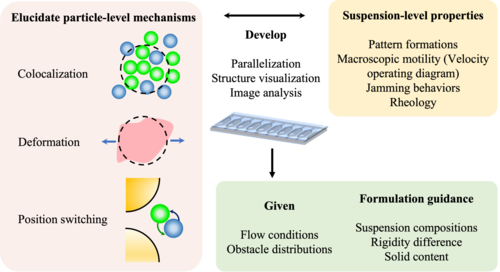To see a World in a Grain of Sand.
- Auguries of Innocence by William Blake
Modern microscopes can measure samples from mesoscale down to nanometer length scale, collecting data from several different channels in parallel, vertical z-stacks, time-lapse sequences, etc, and generate TB of data in a single experimental setting. These reams of data can be exploited using statistical learning to generate useful relationships to guide soft matter structure. Our research aims at bridging the gap between experiments and modeling by designing experimental protocols to enable screening of a comprehensive range of conditions, allowing us to explore fundamental scientific questions about self-assembly and spatial organization.
Theme 1: The rheology and transport of deformable particles.

It is well-recognized that microstructural rearrangement can lead to phenomenally complex behaviors of suspension properties that, when properly harnessed, can aid formulation design. Rheology and jamming of hard colloids are dictated by volume fraction, whereas soft particles can deform and shrink, with additional degrees of freedom. Interactions and coupling between flow and deformation enable soft particles to pass through confined and crowded geometries more easily, making them attractive for enhanced oil recovery purposes. Currently, most literature focuses on idealized systems: hard spheres in unobstructed or regular arrays, at relatively dilute concentrations. The lack of information on the impact of mixtures and transport in random arrays impedes practical applications. The proposed research examines the microstructural evolution under the flow in different types of pseudo-2D, parallelized millifluidic devices and build toward a jamming diagram of mixtures of particles in randomly distributed pillar arrays. These experiments are intended to fill fundamental and practical knowledge gaps and help delineate promising design considerations for soft and hard particle mixtures.
Theme 2: Dynamic cell response and reordering of liquid crystalline substrates
 The physiochemical reciprocity between cells and the extracellular matrix (ECM) underlies many physiological and pathological processes and has motivated research in synthetic ECMs with tunable parameters. Although ECM design often focuses on the “average properties” of the material, the cell behavior is expected to depend sensitively on local heterogeneities that cannot be easily accessed by bulk characterization techniques. Furthermore, the surface properties are often static and do not respond to cell activities. Because of their birefringence, sensitivity to boundary and environmental stimuli, and similarity to cellular arrangements, liquid crystals (LCs) have emerged in recent years as promising materials for cell substrates. Yet the responsiveness of LC has not been fully exploited. Building upon several proof-of-concept examples of cell-LC interactions, this project aims to examine both cells’ response to LC molecular ordering on a static substrate and to establish a platform for tracking the dynamics of cell remodeling on a dynamic substrate . This will be achieved by examining two model cell lines and monitoring the optical response of the LC using time-lapse imaging. Developing these new methodologies will enable a better understanding of cell-substrate interactions and divergent behaviors of different cell types, both of which are essential to design targeted therapeutics.
The physiochemical reciprocity between cells and the extracellular matrix (ECM) underlies many physiological and pathological processes and has motivated research in synthetic ECMs with tunable parameters. Although ECM design often focuses on the “average properties” of the material, the cell behavior is expected to depend sensitively on local heterogeneities that cannot be easily accessed by bulk characterization techniques. Furthermore, the surface properties are often static and do not respond to cell activities. Because of their birefringence, sensitivity to boundary and environmental stimuli, and similarity to cellular arrangements, liquid crystals (LCs) have emerged in recent years as promising materials for cell substrates. Yet the responsiveness of LC has not been fully exploited. Building upon several proof-of-concept examples of cell-LC interactions, this project aims to examine both cells’ response to LC molecular ordering on a static substrate and to establish a platform for tracking the dynamics of cell remodeling on a dynamic substrate . This will be achieved by examining two model cell lines and monitoring the optical response of the LC using time-lapse imaging. Developing these new methodologies will enable a better understanding of cell-substrate interactions and divergent behaviors of different cell types, both of which are essential to design targeted therapeutics.